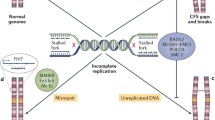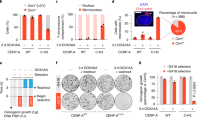Summary
Six heterozygous carriers of a fragile site at 16q22 were available for the current study. We demonstrated that the observed fragile site was a “BrdUrd-sensitive” fra(16)(q22) or FRA16B, capable of spontaneous expression in some individuals (= “spontaneous” FRA16B). Significant differences either in spontaneous or in ethylmethane sulfonate (EMS)-induced sister chromatid exchange (SCE) frequencies were found between the fragile 16q22 site, whether expressed or not, and its homologous normal site. These data complement our previous findings on FRAXA and provide additional arguments indicating that fragility and SCE are variable cytogenetic expressions of the same DNA structural alteration.
Similar content being viewed by others
References
Croci G (1983) BrdU-sensitive fragile site on long arm of chromosome 16. Am J Hum Genet 35:530–533
Glover TW (1981) FUdR induction of the X chromosome fragile site: evidence for the mechanism of folic acid and thymidine inhibition. Am J Hum Genet 33:234–242
Glover TW, Stein CK (1987) Induction of sister chromatid exchanges at common fragile sites. Am J Hum Genet 41:882–890
Glover TW, Berger C, Coyle C, Echo B (1984) DNA polymerase alpha inhibition by aphidicolin induces gaps and breaks at common fragile sites in human chromosomes. Hum Genet 67:136–142
Littlefield LG (1982) Effects of DNA-damaging agents on SCE. In: Sandberg AA (ed) Sister chromatid exchange. Liss, New York, pp 355–394
Lukusa T, Vercauteren P, Van denBerghe H, Cassiman JJ (1988) SCE variability in lymphocytes and fibroblasts. A controlled study. Hum Genet 80:117–123
Lukusa T, Meulepas E, Fryns JP, Van denBerghe H, Cassiman JJ (1990) No significant increase in spontaneous and ethyl methyl sulfonate-induced sister chromatid exchanges at the Xq27. 3 fragile site. Cancer Genet Cytogenet 49:87–94
Painter RB (1982) A replication model for sister chromatid exchange. In: Sandberg AA (ed) Sister chromatid exchanges. Liss, New York, pp 115–121
Sanfilippo S, Neri G, Tedeschi B, Carlo-Stella N, Triolo O, Serra A (1983) Chromosomal fragile sites: preliminary data of a population survey (abstract). Clin Genet 24:295
Schmid M, Klett C, Niederhofer A (1980) Demonstration of a heritable fragile site in human chromosome 16 with distamycin A. Cytogenet Cell Genet 28:87–94
Schmid M, Hungerford DA, Poppen A, Engel W (1984) The use of distamycin A in human lymphocyte cultures. Hum Genet 65:377–384
Schmid M, Feichtinger W, Jebberger A, Köhler J, Lange R (1986) The fragile site (16)(q22). I. Induction by AT-specific DNA-ligands and population frequency. Hum Genet 74:67–73
Schmid M, Feichtinger W, Haaf T (1987) The fragile site (16)(q22). II. Sister chromatid exchanges. Hum Genet 76:365–368
Sutherland GR (1979) Heritable fragile sites on human chromosomes. I. Factors affecting expression in lymphocyte culture. Am J Hum Genet 31:125–135
Sutherland GR (1982) Heritable fragile sites on human chromosomes. VIII. Preliminary population cytogenetic data on the folic-acid-sensitive fragile sites. Am J Hum Genet 34:452–458
Sutherland GR, Hecht F (1985) Fragile sites on human chromosomes. Oxford University Press, New York Oxford, pp 59–94
Sutherland GR, Ledbetter DH (1989) Report of the committee on cytogenetic markers. Cytogenet Cell Genet 51:452–458
Sutherland GR, Baker E, Seshadri RS (1980) Heritable fragile sites on human chromosomes. V. A new class of fragile site requiring BrdU for expression. Am J Hum Genet 32:542–548
Sutherland GR, Jacky PB, Baker EG (1984) Heritable fragile sites on human chromosomes. XI. Factors affecting expression of fragile sites at 10q25, 16q22 and 17p12. Am J Hum Genet 36:110–122
Swinscow TDV (1977) Statistics at square one. British Medical Association, London, pp 43–57
Tommerup N (1986) Induction of the fragile X with simultaneous emonstration of early and late replicating regions and sister chromatid exchanges (abstract). Proceedings of the 7th International Congress of Human Genetics, Berlin, p 221
Wenger SL, Hennessey JC, Steele MW (1987) Increased sister chromatid exchange frequency at Xq27 site in affected fragile X males. Am J Med Genet 26:909–914
Author information
Authors and Affiliations
Rights and permissions
About this article
Cite this article
Lukusa, T., Meulepas, E., Fryns, J.P. et al. “Spontaneous” FRA16B is a hot spot for sister chromatid exchanges. Hum Genet 87, 583–586 (1991). https://doi.org/10.1007/BF00209017
Received:
Revised:
Issue Date:
DOI: https://doi.org/10.1007/BF00209017




